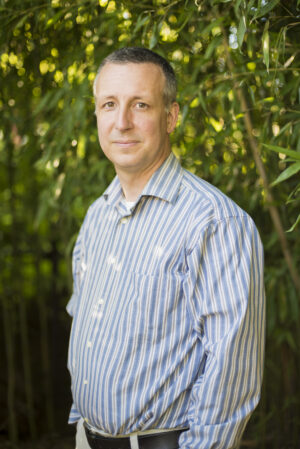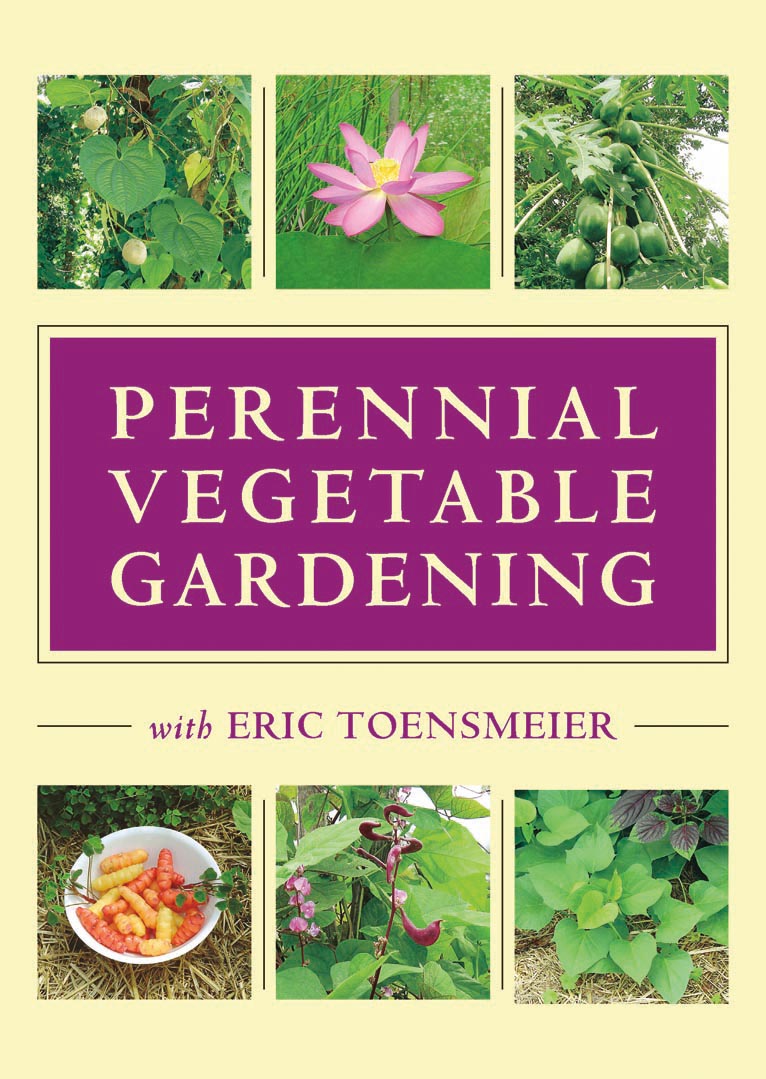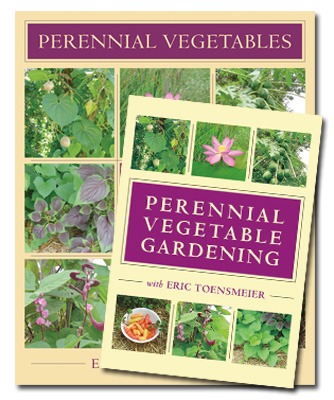Edible Forest Gardens: 2 Volume Set
Edible Forest Gardens is a groundbreaking two-volume work that spells out and explores the key concepts of forest ecology and applies them to the needs of natural gardeners in temperate climates. Volume I lays out the vision of the forest garden and explains the basic ecological principles that make it work. In Volume II, Dave Jacke and Eric Toensmeier move on to practical considerations: concrete ways to design, establish, and maintain your own forest garden. Along the way they present case studies and examples, as well as tables, illustrations, and a uniquely valuable “plant matrix” that lists hundreds of the best edible and useful species.
Taken together, the two volumes of Edible Forest Gardens offer an advanced course in ecological gardening-one that will forever change the way you look at plants and your environment.
What is an edible forest garden?
An edible forest garden is a perennial polyculture of multipurpose plants. Most plants regrow every year without replanting: perennials. Many species grow together: a polyculture. Each plant contributes to the success of the whole by fulfilling many functions: multipurpose. In other words, a forest garden is an edible ecosystem, a consciously designed community of mutually beneficial plants and animals intended for human food production. Edible forest gardens provide more than just a variety of foods. The seven F’s apply here: food, fuel, fiber, fodder, fertilizer, and “farmaceuticals,” as well as fun. A beautiful, lush environment can be a conscious focus of your garden design, or a side benefit you enjoy
Awards
- 2006 Garden Writers Association, Media Award
Reviews and Praise
HortIdeas-
We reviewed the first volume of this two-volume set in September 2005 HortIdeas--in fact, we were so impressed by it that we devoted that month's Book Reviews section entirely to it. Until Mycelium Running--another amazingly important and well-done book--appeared, we were considering doing the same this month for the second volume of Edible Forest Gardens, which is much thicker (by more than 270 pages!) than the first volume. The shorter length of this review certainly does not reflect the relative importance of the volumes--we recommend that anyone interested in experimenting with temperate-zone "gardening in the image of the forest" should study both.Although Volume 2 ostensibly emphasizes "practical" information building on the "theoretical" ideas in Volume 1, it is clear that both volumes are essentially theoretical. That's because (as we discussed in our review of Volume 1) nobody has yet convincingly shown the viability of forest gardening (relying heavily on perennial crops) in temperate areas as a sustainable alternative to conventional gardening (based mainly on annual crops). Jacke and Toensmeier are, admirably, attempting to disseminate ideas gathered from a variety of source that might enable such viability. Ultimately, at this stage development of temperate-zone forest gardening techniques, virtually all approaches are experimental and in need of validation. We simply do not currently know their limitations.
Understanding that knowledge on "nest practices" for temperate-zone forest gardening needs to be established experimentally can be exciting for those willing and able to adopt the scientific attitude: no matter how they turn out, the results of an experiment, performed appropriately (meaning especially that adequate control treatments are provided), are never "bad." In other words, we think that would-be temperate-zone forest gardeners who are sincerely interested in helping to establish this novel form of agriculture should proceed by trying to test some of Jacke and Toensmeier's numerous design, site preparation, species choice and establishment, and management guidelines. We view Volume 2 of Edible Forest Gardens not as a recipe book for what works but rather as a compendium of possibilities for what could work--an invitation par excellence to experimentation instead of complacency. Right on!
More Reviews and Praise
Plants and Gardens News--Patricia Jonas, Brooklyn Botanic Garden-
But even if you grow enough organic food to feed yourself, are you doing what's best for the ecosystem? "Many drawbacks of modern agriculture persist in organic farming and gardening," Dave Jacke and Eric Toensmeier write in Edible Forest Gardens, because they do not "mimic the structure of natural systems, only selected functions." Even Quail Hill Farm members are still harvesting mostly annual crops grown in plowed fields. Jacke and Toensmeier offer a radical vision for stepping out of the conceptual continuum of conventional agriculture and organic farming. They point to the productivity of temperate forests--which is twice that of agricultural land in terms of net calories--and take that as their design model. Building on Robert Hart's classic book, Forest Gardening, and incorporating permaculture practice, Jacke and Toensmeier propose a garden where many species of edible perennial plants are grown together in a design that mimics forest structure and function.Edible Forest Gardens is an ambitious two-volume work whose influence should extend well beyond ecologists and permaculturists and, in the best of all outcomes, reach into the mainstream. Volume one lays out the "Ecological Vision and Theory for Temperate Climate Permaculture," and it also includes a very useful analysis of existing forest gardens (one only 50 by 90 feet) and a tantalizing 30-page appendix of "top 100" species. As of this writing, volume two, which focuses on practical design and maintenance considerations, is just being released, but on the evidence of volume one, I have no doubt the set will be an indispensable reference for gardeners and farmers for decades.
"When people have food gardens," the authors write, "they usually are tucked out of sight and out of view of the neighbors. They rely on external inputs of energy, nutrients, insect and disease controls, and water and are based primarily on annual plants. For some reason, growing food is considered unsightly, unseemly, possibly antisocial, and in some towns and cities, illegal! The tremendous infrastructure we have built in our cities and towns reflects a culture and horticulture of separation and isolation." The consequences of such attitudes about growing food have been disastrous, and each of us can contribute to the repair effort. Jacke and Toensmeier say that the principles of forest gardening can be applied even in a tiny urban yard or on a rooftop. Containers of edible perennials and annuals on a rooftop are not most farmers' idea of agriculture, but I grow nearly 20 percent of the authors' top 100 species and intend to look for ways to take this small start much further.
And what about chocolate and oranges? Clearly there are foods that cannot be grown in a temperate forest. "We do not expect forest gardening to replace regular gardening or the foods we know and love," the authors admit. "Just how far we can take forest gardening in supplying food for ourselves is not yet determined." Finding the answer may be the most optimistic work gardeners and farmers can do.
"These will be the benchmark works in the field for many years. The level of scholarship and meticulous footnoting is unsurpassed by anything I've seen in permaculture literature."--Toby Hemenway, author of Gaia's Garden
"A tree de force! A must-have set of books for anyone serious about polyculture, integrated organic garden and landscape design, permaculture in the temperate zones and, of course, food forests. The charts of condensed information alone are worth the price of admission. The best book on these topics in years Keep these books within arm's reach at all times!"--Robert Kourick, author of Designing and Maintaining Your Edible Landscape Naturally
About The Author
| Pages: | 1068 pages |
| Book Art: | Volume I has full-color illustrations and charts throughout; Volume II has black-and-white illustrations and charts throughout |
| Size: | 8.25 x 10.25 inch |
| Publisher: | Chelsea Green Publishing |
| US Pub. Date: | November 15, 2005 |
| Hardcover: | 9781890132606 |
Available In/Retail Price
Hardcover, 1068 pages, $150USDMEDIA & EVENT INQUIRIES
Media Inquiries:
Contact Publicity at: [email protected] or (802) 295-6300 x 127
Event Inquiries:
To set up an author appearance or event contact Darrell Koerner at [email protected]
Review Copies:
Click here to request a review copy of one of our books.
Rights & Permissions
Email us for rights & permissions inquiries.
SALES CONTACTS
Special, Corporate and Academic Sales
Darrell Koerner
[email protected]
(303) 963-5612
Trade and Library Sales
Kirsten Drew
Book Strategy Manager
[email protected]
Independent Bookstore Sales
To place a retail wholesale order, please contact the appropriate regional representative.
Canadian and Overseas Trade Distribution
To place an international wholesale order, please contact the appropriate foreign trade distributor.
Academic Kit
Request a desk or evaluation copy.










